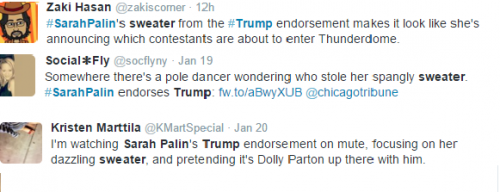When Sarah Palin endorsed Donald Trump, it provided political commentators with a goldmine of analytic fodder. Working through the Palin-Trump team up, there is a lot to untangle.
For instance, how do we make sense of a political climate in which the 2008 vice presidential candidate, who so damaged the presidential campaign of her running mate that he could barely mask his contempt for her on election night, is now a desirable connection?
Or what dynamics were in play that pushed Palin to Trump rather than Cruz, especially given Palin’s support of Cruz in his senate bid?
Or could her endorsement backfire, finally impressing upon moderate Republicans the urgency of nominating Rubio or Bush? And relatedly, what’s up with Rubio falling into the mainstream/moderate category?
While commentators touched on a few of these things, largely, the conversation was dominated by another topic entirely: Sarah Palin’s sweater.
Ewww.
To be clear, I’m not Ewwwing her sweater. In fact, I refuse to comment on her sweater. Because I’m not a sexist asshole. Rather, I’m expressing my disgust that mainstream Republicans and self-proclaimed progressives alike coalesced on social media to discuss a politician’s wardrobe—its attractiveness and appropriateness—and that this story then became the content of broadcast news. I heard CNN news anchor and political correspondent Dana Bash spend about 3 minutes on the sweater, its other appearances (CBS Sunday in November), and how the sweater fits into Palin’s larger repertoire of wardrobe choices. Mashable ran a story on the price of the sweater. And the Washington Post gave the sweater an in-depth analysis. Ewww.
Here’s the thing. Social media are heralded as a democratizing force. The voices of the people flow into the voices of broadcasters, spreading into national and international conversations in ways previously unavailable. Social media are a mechanism for the people to speak in ways that projects out into public life. This is powerful. This has been a major tool in important revolutionary movements from the Arab Spring, to #Occupy, to #BlackLivesMatter. It’s how the public insisted upon a serious discussion of interpersonal violence following the infamous Ray and Janay Rice incident. It’s where Hilary Clinton’s evocation of 9-11 to account for her ties to Wall Street were noticed, critiqued, and given back to her with striking immediacy.
But we don’t live in a media democracy. Broadcast media still have disproportionate control over what does and does not become news. Social media provide content pools, which broadcast outlets sift through to select what they will or will not, address. This means the relationship between social and broadcast media is of a curatorial nature, with broadcasters maintaining more power than those from whom they pull stories. This makes broadcast outlets responsible parties. When they don’t pick up an important story, they are accountable. When they do pick up a story that should have remained in the ether, they are also accountable. Sarah Palin’s Sweater was a story that should have withered and died.
Commenting on professional women’s clothing is sexist. It highlights fashion and beauty while backgrounding substance. It wasn’t okay with Hilary Clinton’s pants suits and it’s not okay with Sarah Palin’s sweater. It is disappointing if not surprising, however, that sexist commentary arises among the populace. It is unacceptable when that sexism translates into a headlining story.
Jenny Davis is on Twitter @Jenny_L_Davis
Headline pic (as seen on Mashable. Credit: AP Photo/Mary Altaffer))



Comments 2
Pat — January 24, 2016
In the context of evaluating a presidential endorsement, it's absolutely irrelevant to comment on someone's clothing. But I don't think you can make a blanket statement that commenting on professional womens' clothing is always sexist. Lots of us are interested in womens' clothing for its own sake, and the fact that the woman happens to be a professional should not rule out my wanting to know where she got that kick-ass sweater.
I'm in total agreement, though, that such discussions belong on Go Fug Yourself rather than CNN, and that drawing inferences about a woman's ability from her wardrobe, or letting discussion of the wardrobe overpower discussion of the woman's ideas, are sexist acts.
jennydavis — January 24, 2016
Hi Pat,
Your point is well taken. There are few things it is never, under any conditions, okay to do (i.e., all claims have scope and your comment taps into the scope of my statement). Of course, there's a qualitative difference between expressing personal interest in an item of clothing (e.g., a kick-ass sweater) and making it the take-away message, as was the case here.